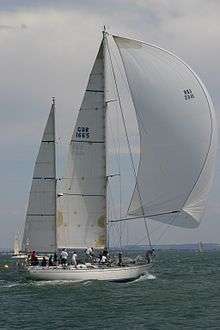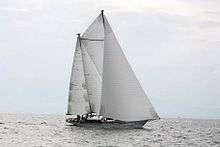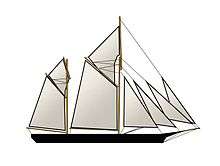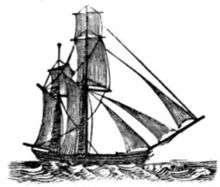Ketch



A ketch is a two-masted sailing craft whose mainmast is taller than the mizzen mast (or aft-mast). The name "ketch" is derived from "catch" or fishing boat.[1][2]
Historically the ketch was a northern European square-rigged vessel, often a freighter or fishing boat, particularly in the Baltic and North seas.
Nowadays, a ketch tends to be a fore-and-aft rigged pleasure yacht, similar to a yawl; but a ketch's mizzen mast is taller and its mizzen sail is larger than a yawl's.
Varieties of modern ketch


The large fore-and-aft sail on the mainmast is the mainsail, while the sail on the mizzen mast is the mizzen. To assist going to windward, a ketch will usually carry at least one foresail such as a jib or genoa.
Although both the single-masted Bermuda sloop and cutter have simpler rigging and are more efficient, the sails on a ketch are smaller and more easily handled, and its mainmast is shorter. A modern ketch's sails may be any type of fore-and-aft sail, in any combination, and most are Bermuda rigged.
The modern ketch is popular in northern Europe and among long distance cruisers. Both the ketch and the yawl rig have proved generally to be more suitable for motorsailers than the Bermuda rig.
In strong winds a ketch's mainsail can be dropped altogether (rather being reefed), thereby reducing sail and leaving a balanced sail-plan with just jib and mizzen set. When sailing with just mizzen and jib set, there is no excessive lee helm, and some claim that the additional sail allows a better balance; and in an emergency the ketch may be steered without use of the rudder. When running before the wind or reaching across the wind, a ketch may set extra sails such as a spinnaker or mizzen staysail on the mizzen mast, as well as a spinnaker on the main mast. When at anchor, the mizzen sail may help to steady the boat, thereby reducing roll in an otherwise uncomfortable anchorage.
The mizzen sail may be flown alone to hold the boat's bow into the wind and oncoming waves. On a fishing boat, this "weathercocking" effect allows nets to be handled without the boat becoming broadsides to the waves, allowing the crew to work in safety.
Other possible rigs on a ketch include gunter rigs and gaff rigs. The Scots Zulu, for example, had a dipping lug main with a standing lug mizzen. One of Sir Francis Chichester's earlier Gypsy Moth ketches had five staysails (each of almost equal size), none of which were boomed. If a ketch has no jibs, it is called a cat ketch or a periauger. On older, larger ketches the main mast may in addition carry one or more square rigged topsails.
Similar rigs
Historical

The square-rigged ketch was largely supplanted by the brig, which differs from the ketch by having a forward mast smaller (or occasionally similar in size) than the after mast, and by the hoy, which was fore-and-aft rigged. Other similar craft include the snow and the pink.
Modern
Both the ketch and the yawl have two masts, with the main mast foremost; the distinction usually being that a ketch has the mizzen mast forward of the rudder post, whereas on a yawl, it is aft of the rudder post.[3][4] But the balance of sail area can be an overriding characteristic. If 20% or more of the sail area is in the mizzen sail the rig would be termed a ketch. This is particularly true on center cockpit yachts. Compared to a ketch, a similar size yawl's mizzen sail is much smaller than the main, because of the limitations of the mizzen sheet. So on a ketch, the dual purpose of the mizzen sail is to both propel and balance the vessel, while on a yawl, the smaller mizzen mainly serves the purpose of trim or balance. Yawls tend to have mainsails almost as large as those of comparable sloops.
A ketch may be distinguished from a cutter or a sloop by virtue of having two masts rather than one, though a ketch with two foresails is sometimes called a "cutter-rigged ketch".
Both the ketch and the yawl differ from the two-masted schooner, whose aft mainmast is taller than the foremast. (It follows that a schooner does not have a mizzen mast.) If a vessel has two masts of approximately the same height, the rig with the larger sail forward is called a ketch, while the rig with the larger sail aft is a schooner. The American two-masted schooner is rare in Europe, where the ketch rig is preferred.
History
In the year 1775, various ketches were utilized as warships by the Sultanate of Mysore during the rule of Hyder Ali.
During the 17th and 18th centuries, ketches were commonly used as small warships, until superseded in this role by brigs during the latter part of the 18th century. The ketch continued in use as a specialized vessel for carrying mortars until after the Napoleonic wars, in this application it was called a bomb ketch.
The original Atlantis, the seagoing research vessel of the Woods Hole Oceanographic Institution commissioned in 1931, was a steel-hulled ketch.[5] In 1989 Bruce Farr designed the Maxi ketch Steinlager 2, the first maxi yacht built of composite carbon construction. This revolutionary lightweight design went on to win the Whitbread Round the World Race in 1989/90.
In popular culture
In 1947 a radio program called Voyage of the Scarlet Queen was set on a ketch. The Scarlet Queen was a 78-foot ketch with a white hull, teak decking, brass bright-work, and sporting the "Scarlet Queen" herself, on the bowsprit, naked as the day she was born, "a fresh, young body... looking forward, ... bold, teasing... dressed in only a crown, and painted brilliant red."
A William Garden–designed Formosa 51 ketch named Wanderer was the main setting in the 1992 film Captain Ron. Three Formosa 51s were used in filming.
A Formosa 51 ketch named Viking Spirit was used in the 2004 romantic comedy 50 First Dates starring Adam Sandler and Drew Barrymore. In the film, the boat was named the Sea Serpent.
See also
References
- ↑ Note: (ketch from Middle English cache, from cacchen, "to catch").
- ↑ "ketch – definition of ketch by the Free Online Dictionary, Thesaurus and Encyclopedia". Thefreedictionary.com. Retrieved 21 February 2012.
- ↑ Maloney, Elbert S. (2006) Chapman Piloting & Seamanship 65th Edition, page 30. Hearst Communications. ISBN 978-1-58816-232-8.
- ↑ Rule F.1.2 of International Sailing Federation (ed.), Equipment Rules of sailing (PDF) (edition valid from 2009 to 2012 ed.), retrieved 13 June 2009
- ↑ "History of WHOI Ships: Woods Hole Oceanographic Institution". Whoi.edu. Retrieved 29 April 2013.
- Jones, Gregory O. (2002). The American Sailboat. St. Paul, Minn.: MBI Publishing Company. ISBN 9780760310021. OCLC 49315350.